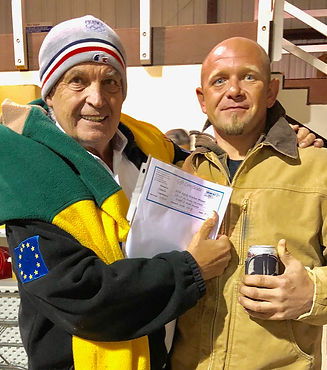

Stand 21 Safety Foundation
“Racing Goes Safer” Seminar with SCTA
El Mirage, California
Saturday November 10, 2018
5PM- 6 PM, Tech Trailer
The third “Racing Goes Safer” drivers’ safety seminar with SCTA took place at El Mirage dry lake in California. After an introduction by Foundation Director Don Taylor, a solid attendance welcomed Ed Becker, Snell Foundation’s Executive Director and Chief Engineer. The subject of the day was of course, helmets.
Mr. Becker described the reasons for the existence of the Snell Foundation after Dr. Snively untimely death following a racing accident. A presentation of the most important points ensued, followed by a brief Q&A session.
After intensive research in updating the philosophy behind helmet design, much technological advancement has been seen over the past 10 years, after the FIA mandated the use of stronger outer shells for top level racing helmets. This new breed of helmets must meet or exceed updated standards, such as the new Snell “EA” and the FIA “8860”. These new helmets are quite expensive but provide at least 25% greater protection than previously achieved with Snell SA2015 or SFI “31” helmets.
Mr. Becker explained the testing methods and equipment, and presented graphs of test using various anvils and drop angles
Important points to the casual user:
- Helmet protection level is “invisible”. Only scientific testing will tell if a given helmet can provide minimal or adequate protection.
- The main difference between a Snell “M” and a Snell “SA” certified helmet is fire retardant properties of the inner padding. Fire is far less likely to affect a motorcycle rider.
- Avoid mounting video cameras on your helmet: in case of impact, the device could act as a torque generating instrument and cause a neck fracture.
- Purchase a helmet that fits you precisely: standard sizes fit some people, but most require fine adjustment of inner padding to their head shape, providing greater safety and far better comfort.
- Keep your helmet away from solvents, gasoline, even from fumes generated by such liquids, as it might damage the EPS liner seen in many helmets, effectively reducing its ability to protect you. This damage may be invisible to the naked eye.
- Urban legend demolished: if you accidentally drop your helmet and it hits the ground from 3 or 4 feet, it will not result in sufficient force to damage it, and it remains effectively intact.
However, always remember that all helmets have a limit in their capacity to protect you. There is a threshold that no helmet in the world can exceed.





Winner!
Congratulations to Peter Shotrosky for winning the Racing Goes Safer/Stand 21 Racewear $150 Gift Card drawing!
We Stand For Safety!

